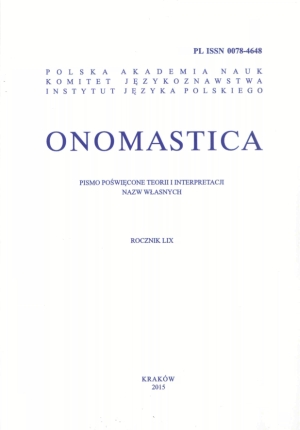Streszczenie
The paper discusses the method of the substitution by homophones that is extensively used in many fields in China, among others onomastics, such as toponymy or anthroponymy. The Chinese language has always contained a considerable number of homophones, i.e. words pronounced alike but spelt/written differently and having different meanings. The situation resulted from two main factors: the nature of the Chinese language and the sound changes to spoken Chinese language, i.e. a strong tendency to sound simplification. The method of the substitution by homophones is mainly aimed at reshaping already existing names by replacing their previous form, for some reasons unwanted. However, it is also broadly applied to create new names by using words which are homophonic with the words denoting the idea they symbolize. The paper presents some various reasons and aims of the use of the method in the domain of Chinese geographical names, and the more detailed analysis of its use in the changing of old street (hutong) names after 1949 in Beijing. The research material consists of 1,159 hutong names, and the names changed by the use of the method accounts for 23.5% of the total.
Bibliografia
Hartman, R.R.K., Stork F. C. (1972). Dictionary of Language and Linguistics. London. [Chinese translation: Yuyan yu yuyanxue cidian 语言与语言学词典 (1981)]. Shanghai: Shanghai Cishu Chubanshe.
HYC, Han-Yingcidian 汉英词典 [A Chinese-English Dictionary]. (1995). Beijing: Waiyu Jiaoxue yu Yanjiu Chubanshe.
Kałużyńska, I. (1990). The Taboo and Chinese Geographical Names. Orientalia Varsoviensia, no 3, pp. 17–35.
Kałużyńska, I. (1995). The Substitution by Homophones in Chinese Geographical Names. Rocznik Orientalistyczny, 50, no. 1, pp. 123–135.
Kałużyńska, I. (2002). Contemporary Chinese Place Names. Names of Administrative Divisions at County and City Level. Bern–Berlin–Bruxelles–Frankfurt am Main–New York–Oxford–Wien: Peter Lang. [Schweizer Asiatische Studien. Monographien, 33].
Kałużyńska, I. (2008). Chinese Female Namings. Past and Present. Warszawa: AGADE.
Kałużyńska, I. (2015). Chinese Naming — Substitution by Homophones. Acta Asiatica Varsoviensia, 28, pp. 79–91.
Liu, J. [刘建斌] (1982). Beijing yixie jiexiang mingcheng de xieyin zhuanyi bianhua 北京一些街巷名称的谐音转义变化 [Change of meaning by substitution by homophones in street names in Beijing]. Diming zhishi 地名知识 [Toponymic Knowledge], no. 5, pp. 25–26.
Qin, Y. [秦樱] (1980). Lüelun Mingdai diming de geng, ming ming 略论明代的更,命名 [Outline of names renamed or established during Ming Dynasty]. Diming zhishi 地名知识 [Toponymic Knowledge], no. 1, pp. 3–8, 15.
Ren, C. [任传兴] (1984). Tantan diming de yanbian 谈谈地名的演变 [Talking about the evolution of place names]. Diming zhishi 地名知识 [Toponymic Knowledge], no. 1, pp.11–12.
Rong, R. [容熔] (1984). Qiantan Taiwan de diming浅谈台湾的地名 [A preliminary discussion on Taiwan place names]. Diming zhishi 地名知识 [Toponymic Knowledge], no. 3, pp. 10–12.
Sulikowska, I. (1987). Z zagadnień toponomastyki chińskiej. Zjawisko tabu a nazwy geograficzne. Nazwy er panowania cesarzy w nazewnictwie geograficznym [Chinese toponymic issues: Taboo and geographical names. Names of imperial eras in geographical names]. Przegląd Orientalistyczny, 142, no. 2, pp. 175–189.
Sung, M. M. Y. (1979). Chinese Language and Culture: A Study of Homonyms, Lucky Words and Taboos. Journal of Chinese Linguistics, no. 7, pp.15–28.
Wang, W. [王文周] (1984). Diming zhuanyongzi de xiangsi tongyinzi daiti 地名专用字的相似同音字代替 [Substitution by homophones of the characters/words for the special toponymic use]. Xinyang Shifan Xueyuan Xuebao 信阳师范学院学报 [Scientific Bulletin of Xinyang Teachers’ College], no. 3, pp. 110–114.
Weng, L. [翁立] (1997). Beijing de hutong 北京的胡同 [Streets of Beijing]. Beijing: Beijing Yanshan Chubanshe.
XXHC, Xin Xiandai Hanyu Cidian 新现代汉语词典 [A New Dictionary of Modern Chinese Language] (1992). Haikou: Hainan Chubanshe.
Zhang, Q. [张清常] (1997). Beijing jiexiang mingcheng shihua — shehui yuyanxue de zai tansuo 北京街巷名称实话 — 社会语言学的再探索 [Facts on names of streets in Beijing — Explorations of sociolinguistics]. Beijing: Beijing Yuyan Wenhua Daxue Chubanshe.
Zhang, S. [张绍麒] (1988). Diming yanbian zhong de xieyin huanming 地名演变中的谐音换名 [Homophonic changes in the development of place names]”. Diming zhishi 地名知识 [Toponymic Knowledge], no. 4, pp. 3–5.


